A Vessel’s Journey Through the Reglass Process
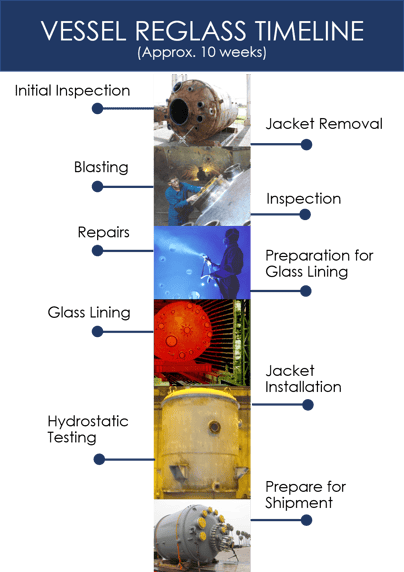
We’ve written in the past about How Glass-Lined Vessels are Made, as well as What is Reglassing and How it Can Work for You. We’ve even taken you through the Steps for Sending your Vessels in for Reglassing. But what exactly happens to your vessel once it arrives at our facility?
You probably won’t experience the same emotions shipping your vessel off as you did when you sent your child off to their first day of school. But just because you aren’t agonizing over the safety and well-being of your vessel doesn’t mean you’re not somewhat curious to know what goes on behind the closed doors of our plant.
And unlike a child who can tell you all about their day when you pick them up, your vessel is not going to share its reglass experience with you after being returned from its trip to De Dietrich Process Systems’ manufacturing plant in Corpus Christi, Texas. That’s where this article comes in – we’ll take you step by step through the journey your vessel takes as it is transformed from a damaged/old/worn/used vessel to a virtually new piece of equipment. That’s right – just like a new vessel would be made, a reglassed vessel is meticulously produced with an impermeable surface finish that achieves an optimum balance of corrosion resistance, thermal properties and mechanical strength. Here are the steps it takes to get there:
(Note: This is an example of a typical reglass timeline, which is estimated to take approximately 10 weeks. Actual project time can vary and is dependent on initial vessel condition, vessel size, optional upgrades selected, and other factors.)
Weeks 1-2:
Initial Inspection
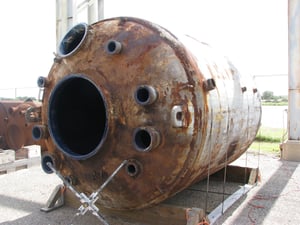 Upon receipt at our facility in Corpus Christi, Texas, the vessel is examined, and inspection details are carefully documented. This step is extremely important, even if your vessel has already been prequalified by one of our service technicians in the field. The equipment that comes in for reglass service may exhibit little or no exterior corrosion when first inspected in the field. However, after the removal of the jacket and blasting, both the vessel exterior and jacket interior may be so severely corroded that extensive repairs, and/or downrating may be required. On the contrary, another vessel (or other piece of equipment) may appear to be severely corroded, and later prove to have adequate steel thickness to maintain the original design condition. Once the initial inspection has been completed, DDPS will determine whether to proceed.
Upon receipt at our facility in Corpus Christi, Texas, the vessel is examined, and inspection details are carefully documented. This step is extremely important, even if your vessel has already been prequalified by one of our service technicians in the field. The equipment that comes in for reglass service may exhibit little or no exterior corrosion when first inspected in the field. However, after the removal of the jacket and blasting, both the vessel exterior and jacket interior may be so severely corroded that extensive repairs, and/or downrating may be required. On the contrary, another vessel (or other piece of equipment) may appear to be severely corroded, and later prove to have adequate steel thickness to maintain the original design condition. Once the initial inspection has been completed, DDPS will determine whether to proceed.
Jacket Removal
If the vessel has a jacket, the jacket will be removed, and a second external inspection is performed to check the condition of the steel. This step is critical to ensure that the steel shell of the reactor body is in a usable state.
Weeks 3-4:
Blasting
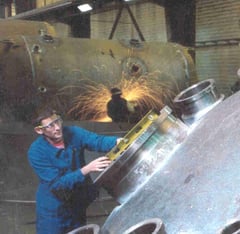 Both the inner chamber and jacket are grit-blasted. This process involves using a forced stream of abrasive material against the glass surface as well as the exterior of the vessel to remove all glass, paint, and any oxidation that has built-up over years of use and exposure.
Both the inner chamber and jacket are grit-blasted. This process involves using a forced stream of abrasive material against the glass surface as well as the exterior of the vessel to remove all glass, paint, and any oxidation that has built-up over years of use and exposure.
Inspection after Blasting
The inside of the vessel and jacket are examined again to determine the extent of base-metal corrosion. Ultrasonic testing is performed to measure the thickness of the base metal. If there are low areas, our engineering team will perform calculations to determine if the vessel can maintain the initial design conditions. At this point, we notify the customer of the outcome. During this status update, we’ll inform you if a downrate is required and get approval to proceed or address any concerns you might have.
Weeks 5-6:
Proceed with Repairs
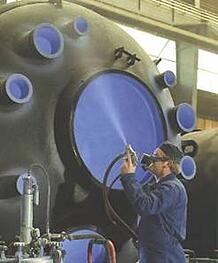 Weld repairs are made to the inner vessel and the jacket (if jacketed). This step can vary greatly in time and intensity, as the condition of the vessel can significantly impact the level of repairs required to get it in satisfactory condition for the glassing procedure. In addition to repairs, this is also the time that upgrades can be made to your vessel, including OptiMix baffles, extra nozzles and insulation rings.
Weld repairs are made to the inner vessel and the jacket (if jacketed). This step can vary greatly in time and intensity, as the condition of the vessel can significantly impact the level of repairs required to get it in satisfactory condition for the glassing procedure. In addition to repairs, this is also the time that upgrades can be made to your vessel, including OptiMix baffles, extra nozzles and insulation rings.
Preparation for Glass Lining
The steel surfaces are prepared for glassing, including grit blasting. This smooths the steel surface and gets it ready for the first coat of glass, known as the ground coat. This base coat has limited corrosion resistance but is important in developing a chemical bond between the subsequent glass layers and the base metal.
Weeks 7-8:
Glass Lining Application
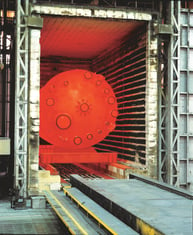 The glass lining process is exactly the same as the procedure for fabricating a new vessel. In short, the vessel interior is sprayed with glass, dried, fired, and cooled. The cycle is repeated until the desired glass thickness is attained. Read about this process in more detail in our post on How Glass-Lined Vessels are Made.
The glass lining process is exactly the same as the procedure for fabricating a new vessel. In short, the vessel interior is sprayed with glass, dried, fired, and cooled. The cycle is repeated until the desired glass thickness is attained. Read about this process in more detail in our post on How Glass-Lined Vessels are Made.
Weeks 9-10:
Jacket Installation
After glass lining is complete, the jacket, which has undergone repairs, is ready to be installed (welded) to the vessel. The diagram below depicts how the jacket shell and jacket head (already welded together) are welded onto the closure rings:
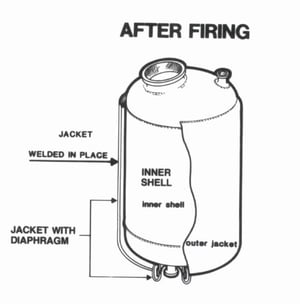
Hydrostatic Testing
This is a common test performed in pressurized equipment to test for strength and leaks. It involves filling the vessel or jacket with water, pressurizing the equipment to the maximum pressure allowance, and observing if there is pressure loss or leakage. The jacket is always hydrostatically tested; the inner vessel will be tested only if major code repairs or alterations were done. Hydrostatic testing helps to establish the integrity and reliability of the vessel and jacket by ensuring its safety and durability.
Prepare for Shipment
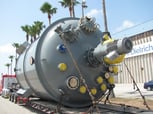 After the hydrotest, the vessel is painted and then prepared for shipment. To signify that the vessel meets applicable codes, a new nameplate with an "R'' stamp will be attached to the vessel next to the original nameplate. At this point you are about to receive a truly “like new” vessel. The warranty on a reglassed De Dietrich vessel carries the same warranty as a newly fabricated vessel!
After the hydrotest, the vessel is painted and then prepared for shipment. To signify that the vessel meets applicable codes, a new nameplate with an "R'' stamp will be attached to the vessel next to the original nameplate. At this point you are about to receive a truly “like new” vessel. The warranty on a reglassed De Dietrich vessel carries the same warranty as a newly fabricated vessel!
That concludes our virtual tour of a vessel’s journey through our reglass process. With insight on this approximate 10-week process, you now know the steps your vessel is undergoing to complete its amazing transformation into a “new” vessel. Reglassing is an environmentally and budget friendly way to repair, upgrade, and extend the life of an existing vessel. For more information on pricing, or to get your vessel prequalified for the reglass process, fill out our Return Equipment Questionnaire or contact us.
